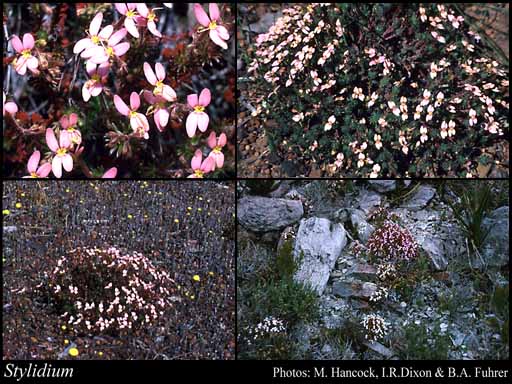- Reference
- Sp.Pl. [Linnaeus] p7, 146. (1805)
- Name Status
- Current

Scientific Description
Family Stylidiaceae.
Habit and leaf form. Erect or creeping herbs, or herbaceous climbers. Annual (ephemeral, with a bulbous rootstock), or perennial (with a woody rootstock); plants with a basal concentration of leaves (often), or with neither basal nor terminal concentrations of leaves, or with terminal rosettes of leaves; rhizomatous, or tuberous. Self supporting (mostly), or climbing (rarely); when scandent, scrambling (Stylidium scandens, via leaf tips recurved into hooks). Helophytic (in bogs), or mesophytic to xerophytic. Leaves alternate (usually, conspicuously so), or whorled (Stylidium scandens); spiral; ‘herbaceous’, or leathery; imbricate; subsessile; sheathing; simple. Leaf blades entire; parallel-veined; without cross-venules. Leaves without stipules. Stem anatomy. Secondary thickening anomalous; from a single cambial ring.
Reproductive type, pollination. Fertile flowers hermaphrodite. Unisexual flowers absent. Plants hermaphrodite. Entomophilous. Pollination mechanism characteristically conspicuously specialized (the stylar column springing forcibly from one side when triggered).
Inflorescence and flower features. Flowers solitary, or aggregated in ‘inflorescences’; in cymes, or in racemes, or in panicles. The terminal inflorescence unit cymose, or racemose. Inflorescences scapiflorous, or not scapiflorous; terminal. Flowers bracteate; small to medium-sized; very irregular; resupinate, or not resupinate. The floral asymmetry involving the perianth and involving the androecium. Flowers 5 merous; cyclic; pentacyclic. Floral receptacle developing an androphore (the peculiar ‘stylar column’, which bears the stigma and the anthers at its tip, sometimes being thus interpreted), or with neither androphore nor gynophore (if the column is interpreted as a gynostemium). Free hypanthium present. Perianth with distinct calyx and corolla; 10; 2 -whorled; isomerous. Calyx 5; 1 -whorled; partially gamosepalous (bilabiate, or with 3 members free and the other 2 connate), or polysepalous; imbricate; bilabiate, or unequal but not bilabiate; with the median member posterior. Corolla 5; 1 -whorled; gamopetalous; imbricate (and resupinate or partly so); unequal but not bilabiate; white, or cream, or yellow, or orange, or red, or pink, or purple, or blue; spurred, or not spurred. Androecium 2. Androecial members free of the perianth; united with the gynoecium (seemingly forming a column with the style, the stigma and stamens borne at the tip of the column); coherent; 1 - adelphous (via the gynostemium); 1 -whorled (posterior-lateral). Androecium exclusively of fertile stamens. Stamens 2; reduced in number relative to the adjacent perianth. Anthers usually elliptic in outline, sometimes with ciliate glands; dehiscing via longitudinal slits; extrorse; tetrasporangiate. Gynoecium 2 carpelled. The pistil 1 celled, or 2 celled. Carpels reduced in number relative to the perianth. Gynoecium syncarpous (but sometimes pseudomonomerous by abortion); eu-syncarpous; inferior. Ovary unilocular, or plurilocular; 2 locular (usually), or 1 locular (by abortion of the posterior locule). Gynoecium median. Epigynous disk present, or absent. Gynoecium non-stylate (usually, the stigma sessile between the anthers), or stylate. Styles 1. Stigmas 1 - lobed; hairy, cushion-shaped, rarely strap-like or finger-like; dry type; papillate; Group II type. Placentation when both locules fertile axile. Ovules in the single cavity when only one locule fertile 1, or 4; 15–50 per locule (‘many’); pendulous, or horizontal, or ascending; anatropous.
Fruit and seed features. Fruit fleshy, or non-fleshy; dehiscent; a capsule; 4–100 seeded (‘few to many’). Seeds endospermic. Endosperm oily. Seeds minute. Cotyledons 2. Seedling. Germination phanerocotylar.
Physiology, biochemistry. Aluminium accumulation not found.
Geography, cytology, number of species. Native of Australia. Not endemic to Australia. Australian states and territories: Western Australia, Northern Territory, Queensland, and New South Wales. Northern Botanical Province, Eremaean Botanical Province, and South-West Botanical Province.
Additional characters Perianth of 5 similar members and the median inner member modified into the labellum (lobes frequently in 2 pairs, usually arranged either laterally, with 1 posterior and 1 anterior lobe lying together, or arranged vertically, with the 2 anterior lobes vertical and the 2 posterior lobes extended, rarely arranged in a fan shape). Column elongated, usually exserted beyond the corolla, mobile, irritable, when poised bent down between and lower than the corolla lobes. Labellum not motile (small, usually recurved, sometimes with broad or narrow appendages; throat bare or with 2–8 appendages).